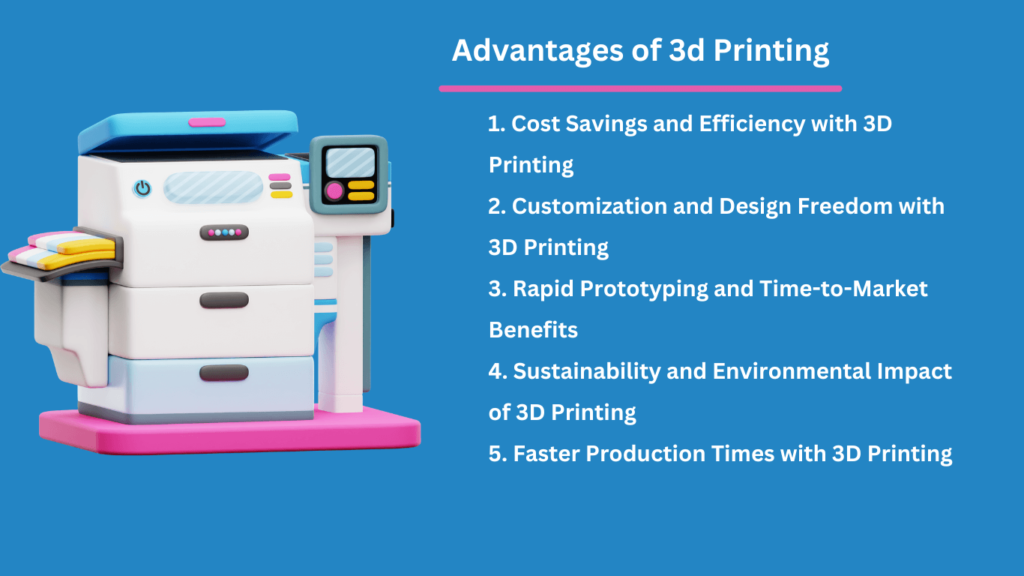Advantages of 3d Printing : In recent years, the manufacturing industry has undergone a dramatic transformation with the introduction of 3D printing technology. Also known as additive manufacturing, 3D printing has revolutionized the way products are designed, prototyped, and produced.

This article delves into the numerous advantages that 3D printing brings to the manufacturing landscape. From cost savings and efficiency to customization and design freedom, rapid prototyping and time-to-market benefits to the sustainability and environmental impact, and faster production times, we will explore how 3D printing is reshaping the future of manufacturing.
3d Printing Advantages | advantages 3d printing
1. Cost Savings and Efficiency with 3D Printing
One of the major advantages of 3D printing is its ability to significantly reduce production costs and improve overall efficiency. Traditional manufacturing processes often involve multiple steps, including the use of molds, tooling, and assembly lines. These processes can be time-consuming and expensive.
Moreover, 3D printing enables on-demand production, eliminating the need for large-scale manufacturing and warehousing. This just-in-time production approach reduces inventory costs and eliminates the risk of overproduction, ultimately leading to significant cost savings.
Furthermore, 3D printing allows for easy customization and iteration, allowing manufacturers to quickly respond to customer demands and market trends. This flexibility not only improves efficiency but also reduces the risk of obsolete inventory, ensuring that products are always up-to-date.
2. Customization and Design Freedom with 3D Printing
With 3D printing, manufacturers have unparalleled design freedom and the ability to create highly customized products. Traditional manufacturing processes often come with design limitations due to the constraints of molds and tooling. However, 3D printing allows for complex geometries and intricate designs that were previously impossible or costly to produce. This opens up new possibilities for product innovation and differentiation.
This customization can range from personalized consumer products to highly specialized medical devices. By leveraging 3D printing technology, manufacturers can create products that perfectly fit their customers’ requirements, leading to higher customer satisfaction and brand loyalty.
3. Rapid Prototyping and Time-to-Market Benefits
Another significant advantage of 3D printing is its ability to accelerate the product development process through rapid prototyping. In traditional manufacturing, creating prototypes can be time-consuming and expensive, often requiring specialized tooling. With 3D printing, designers can quickly turn their digital designs into physical prototypes, allowing for rapid iteration and refinement.
By eliminating the need for tooling and reducing production lead times, manufacturers can bring their products to market much more quickly. This agility is particularly valuable in fast-paced industries where being the first to market can make all the difference. The ability to rapidly prototype and iterate also allows manufacturers to gather valuable feedback from customers and make necessary improvements before full-scale production.
4. Sustainability and Environmental Impact of 3D Printing
In today’s world, sustainability is a key consideration for manufacturers. 3D printing offers several environmental benefits that contribute to a more sustainable manufacturing industry. Unlike traditional manufacturing methods that often generate significant amounts of waste, 3D printing is an additive process that only uses the necessary amount of material, reducing waste generation.
Moreover, 3D printing enables local production, reducing the need for long-distance shipping and associated carbon emissions. By producing goods closer to the point of consumption, manufacturers can minimize transportation costs and reduce their carbon footprint. Furthermore, the ability to produce spare parts on-demand using 3D printing reduces the need for large inventories, leading to more efficient resource utilization and reduced waste.
5. Faster Production Times with 3D Printing
Traditional manufacturing processes often involve complex supply chains and long lead times. However, 3D printing offers the potential for significantly faster production times. With traditional manufacturing, the production process may require sourcing raw materials, manufacturing components, and assembling the final product. In contrast, 3D printing allows for the direct production of finished goods from digital designs, eliminating many of these time-consuming steps.
The speed of 3D printing can vary depending on the complexity and size of the object being printed, as well as the specific technology used. However, advancements in 3D printing technology continue to improve the speed and efficiency of the process. As the technology evolves, it is expected that the production times will continue to decrease, further enhancing the advantages of 3D printing in terms of speed and responsiveness.
Conclusion : Advantages of 3d Printing
As we have explored in this article, 3D printing brings numerous advantages to the manufacturing industry. From cost savings and efficiency to customization and design freedom, rapid prototyping and time-to-market benefits to sustainability and environmental impact, and faster production times, 3D printing is revolutionizing the way products are made.
With its ability to reduce costs, improve efficiency, and enable on-demand production, 3D printing is reshaping the future of manufacturing. As the technology continues to evolve, we can expect even more innovative applications and benefits from 3D printing in the years to come.